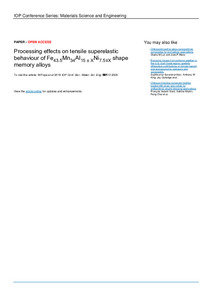| dc.date.accessioned | 2023-05-19T07:10:35Z | |
| dc.date.available | 2023-05-19T07:10:35Z | |
| dc.date.issued | 2019 | |
| dc.identifier | doi:10.17170/kobra-202305198049 | |
| dc.identifier.uri | http://hdl.handle.net/123456789/14722 | |
| dc.description | Creative Commons Attribution 3.0 licence | |
| dc.language.iso | eng | eng |
| dc.rights | Namensnennung 4.0 International | * |
| dc.rights.uri | http://creativecommons.org/licenses/by/4.0/ | * |
| dc.subject.ddc | 620 | |
| dc.subject.ddc | 660 | |
| dc.title | Processing effects on tensile superelastic behaviour of Fe43.5Mn34Al15 ± XNi7.5∓X shape memory alloys | eng |
| dc.type | Aufsatz | |
| dcterms.abstract | Fe₄₃.₅Mn₃₄Al₁₅Ni₇.₅ was introduced in the current decade as a new superelastic alloy with great applicative potential due to: (i) superelastic behaviour over a thermal range of 200°C and (ii) recoverable strains up to 9.7 %. One of the key factors in enhancing the superelastic response of several shape memory alloys (SMAs) is the formation of an oligocrystalline structure, i.e. without triple junctions between grains, which is the result of an abnormal grain growth (AGG) process that can be induced by cyclic heat treatment (CHT). Considering that, up to present date, no systematic observations were reported on the effects of Al substitution with Ni, the present study aims to analyse precisely these effects of on the structure and properties of Fe43.5Mn34Al15-xNi7.5+x, where x = 0; 1.5 and 3 at. %. The ingots with the five above mentioned compositions were: (i) cut by wire electrical discharge machining (WEDM); (ii) hot rolled (HR) at 1060°C with 43.7-70 % thickness reduction degrees; (iii) annealed (A) at 900°C/1h/water, (iv) cold rolled (CR) with 60-92.7 % thickness reduction degrees; (v) cut by WEDM under the configuration of tensile specimens; (vi) subjected to CHT between 1225 and 900°C with heating-cooling rates of 10°C/min (repeated three times) and final water cooling to 80°C before being subjected to (vii) final ageing (AT) at 200°C for 3 hours/water. After applying this complex thermomechanical procedure, the specimens were analysed by optical microscopy (OM) and the average diameter of crystalline grains was calculated based on dimensional measurements. Considering that the approximate specimen thickness was 1 mm, since the average grain size of thermomechanically treated specimens ranged between 1.3 and 3.7 mm, it can be concluded that oligocrystalline structure, characterized by grain size larger than specimen's thickness/diameter has been obtained. Tensile tests were performed on thermomechanically treated specimens, both up to failure and by loading-unloading. The evolution of average hardness, during the five processing stages, HR-A-CR-CHT and AT was determined and discussed. | eng |
| dcterms.accessRights | open access | |
| dcterms.creator | Popa, Mihai | |
| dcterms.creator | Pricop, Bogdan | |
| dcterms.creator | Comaneci, Radu I. | |
| dcterms.creator | Gurau, Gheorghe | |
| dcterms.creator | Vollmer, Malte | |
| dcterms.creator | Krooß, Philipp | |
| dcterms.creator | Niendorf, Thomas | |
| dcterms.creator | Bujoreanu, Leandru Gheorghe | |
| dc.relation.doi | doi:10.1088/1757-899X/591/1/012026 | |
| dc.subject.swd | Memory-Legierung | ger |
| dc.subject.swd | Pseudoelastizität | ger |
| dc.subject.swd | Kornwachstum | ger |
| dc.subject.swd | Mechanische Eigenschaft | ger |
| dc.type.version | publishedVersion | |
| dcterms.source.identifier | eissn:1757-899X | |
| dcterms.source.journal | IOP Conference Series: Materials Science and Engineering | eng |
| dcterms.source.volume | Volume 591 | |
| kup.iskup | false | |
| dcterms.source.articlenumber | 012026 | |


